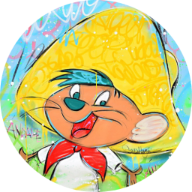About Me
I have always had excellent sensitivity for painting.
From a very young age, I felt a deep sensitivity toward painting—a natural connection that eventually became my true calling. I made the life-changing decision to fully dedicate myself to art, and over time, that journey has brought me to this exciting and fulfilling moment in my career.
I was born in Barcelona, a vibrant city that has shaped my artistic identity. My creative path began with graffiti during my teenage years, but I soon discovered my true passion lay in large-scale canvas painting.
I draw inspiration from the beauty that surrounds me daily—light, nature, emotions, and the subtle details that often go unnoticed. My work is defined by a joyful and luminous color palette, a reflection of my optimistic and passionate outlook on life.
Each piece I create aims to capture and preserve that beauty, transforming it into art to be shared with the world.
I am a self-taught artist impacted by very different artistic styles.
I am a self-taught artist deeply influenced by a wide range of artistic styles that enrich my creative vision. I draw inspiration from subtle elements of realism, surrealism, and expressionism, while blending features from pop art, street art, Baroque, classical, and neoclassical styles into my paintings.
My works often include portraits of iconic cultural figures, especially from cinema and music. Every piece, regardless of size, carries a subtle tribute to the artists I admire and who have fueled my creativity.
I have been honored to exhibit my art in countries such as France, Austria, the United States, and of course, my native Spain. Through pop and street art styles, my vibrant, colorful pieces aim to convey joy, positive energy, and well-being. I invite you to relive your most cherished memories with the freshness and emotion of the very first time.
What Is Popart?
It is an art movement that emerged in the United Kingdom and the United States during the mid- to late-1950s.
Pop art is an art movement that emerged in the 1950s and flourished in the 1960s in America and Britain, drawing inspiration from sources in popular and commercial culture. Different cultures and countries contributed to the movement during the 1960s and 70s.
Emerging in the mid-1950s in Britain and late 1950s in America, pop art reached its peak in the 1960s. It began as a revolt against the dominant approaches to art and culture and traditional views on what art should be. Young artists felt that what they were taught at art school and what they saw in museums did not have anything to do with their lives or the things they saw around them every day. Instead, they turned to sources such as Hollywood movies, advertising, product packaging, pop music and comic books for their imagery.
In 1957 pop artist Richard Hamilton listed the ‘characteristics of pop art in a letter to his friends the architect’s Peter and Alison Smithson:
Modernist critics were horrified by the pop artists’ use of such ‘low’ subject matter and by their apparently uncritical treatment of it. In fact, pop both took art into new areas of subject matter and developed new ways of presenting it in art and can be seen as one of the first manifestations of postmodernism.
Although they were inspired by similar subject matter, British pop is often seen as distinctive from American pop.
Early pop art in Britain was fuelled by American popular culture viewed from a distance, while the American artists were inspired by what they saw and experienced living within that culture.
In the United States, the pop style was a return to representational art (art that depicted the visual world in a recognisable way) and the use of hard edges and distinct forms after the painterly looseness of abstract expressionism. By using impersonal, mundane imagery, pop artists also wanted to move away from the emphasis on personal feelings and personal symbolism that characterised abstract expressionism.
In Britain, the movement was more academic in its approach. While employing irony and parody, it focused more on what American popular imagery represented, and its power in manipulating people’s lifestyles. The 1950s art group The Independent Group (IG), is regarded as the precursor to the British Pop art movement.
Similar to and arguably inspired by Dadaism, Pop Artists often created unusual and nonsensical combinations of ‘found’ or ‘ready-made’ objects and imagery of popular, political or social phenomena. These objects or images are often displayed in collages, arranged in an artistic process called Appropriation. This is the copying, borrowing or altering of images or objects from mass popular culture.
With the rise of consumer culture and a proliferation of visual phenomena thanks to ever-expanding mass media outlets, Appropriation took on an entirely new significance in art.
Pop Artists also appropriated design industry processes such as commercial screen printing and immensely graphic layouts mimicking the ads, billboards, catalogues and other marketing propaganda embedded in the world around them. For this reason, the style was originally referred to as ‘Propaganda Art’.
Pop art continues to be an inexhaustible source of inspiration for fashion, design, the entertainment industry, advertising methods, popular culture in general, over and over again.

